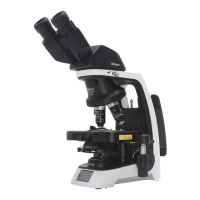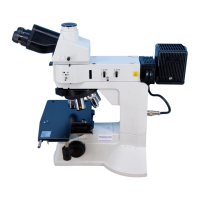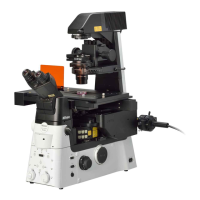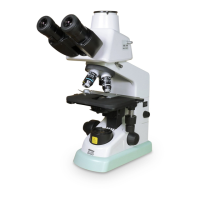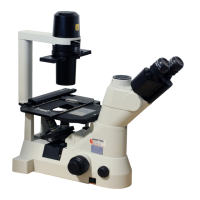Chapter 2 Troubleshooting
28
Troubleshooting
Problem Cause Measure
Parts are attached incorrectly.
Confirm that parts (nosepiece, condenser, etc.) are
correctly attached.
(→See Chapter 1, “3 Assembly Method” in the
“Assembly/Maintenance”.)
Movable part of manually operated unit is not
switched correctly.
Correctly set the optical path switching knob,
nosepiece, filter cube switchover turret, condenser
turret, and slider, etc. (Move the part until it clicks.)
Field diaphragm image is not focused on the
specimen surface.
Make sure the condenser is focused and centered.
(See Chapter 3, “5 Focusing and Centering the Condenser”
in the “Operation”.)
Lack of visibility around
periphery of field of view.
Illumination is uneven
across the field of view.
Field of view is not visible.
Field diaphragm is stopped down too far.
Open the field diaphragm slightly wider than the
field of view.
(→See Chapter 3, “8 Adjusting the Field Diaphragm” in the
“Operation”.)
Incorrect combination of the objective with the
condenser.
Adopt an appropriate combination.
(→See Chapter 3, “7.1 Compatibility of Condenser Type
and Objective Magnification” in the “Operation”.)
When using objectives with 4x or less, 2-4x
auxiliary lens of universal condenser is not in
the optical path or condenser switching such as
swing-out or sliding operation is not performed.
Bring 2-4x auxiliary lens of universal condenser in
optical path.
For other condensers, swing-out or slide the
condenser.
The lamp is attached incorrectly.
Attach it correctly.
(→See Chapter 1, “3 Assembly Method, 3 Attach the lamp”
in the “Assembly/Maintenance”.)
Lack of visibility around
periphery of field of view.
Illumination is uneven
across the field of view.
Field of view is not visible.
The lens and specimen are dirty or dusty.
Clean them as appropriate.
(→See Chapter 3, “2.1 Cleaning Lenses” in the
“Assembly/Maintenance”.)
The specimen is upside down.
Turn up the cover glass and attach it to the stage.
(→See Chapter 2 “2 Bright/Dark-field Microscopy - 7 Place
a specimen on the stage, and move the stage to bring the
target into view” in the “Operation”.)
The thickness of the cover glass is inadequate.
Attach a cover glass of the specified thickness (0.17
mm).
Out of focus with an
objective of high
magnification.
Fail-safe device for specimen damage
protection of the objective is pushed in.
Some objective has a stopper to keep the pushed in
state. Turn the tip of the object to release.
If the objective does not have a stopper, do not pull
because the tip cannot be turned. In this case,
contact your nearest Nikon representative.
Objective lens is attached incorrectly.
Screw the objective all the way in.
(→See Chapter 1, “3 Assembly Method - 15 Attach the
objective” in the “Assembly/Maintenance”.)
A focal deviation is high
when switching over
objectives.
Diopter adjustment has not been performed.
Perform diopter adjustment.
(→See Chapter 3 “4 Adjusting the Diopter” in the
“Operation”.)
The stage is attached incorrectly.
Attach it correctly.
(→See Chapter 1, “3 Assembly Method - 12 Attach the
stage” in the “Assembly/Maintenance”.)
Image is not in focus
although the stage is raised
to the highest position.
The refocusing position is set lower than the
focusing position.
Loosen the coarse focus clamp ring to the limit
which clamps the refocusing mechanism.
(→See Chapter 3 “2.3 Refocusing” in the “Operation”.)
